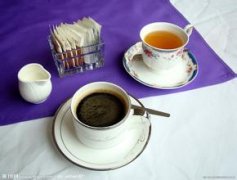A brief introduction to the treatment method of Grinding scale and Baking degree of Yunnan Tieka Coffee beans

Before going, Brother Zou told me that there was an old variety in his relative's house, but what he saw excitedly was a crazy growing coffee forest, which belonged to his aunt. Because the aunt was too old to change to plant and renovate-- so these old varieties survived, but the aunt was unable to manage it alone, so he let the tree grow naturally and pick some fruit when it matured.
Typica and Bourbon, two classic high-quality coffee varieties, are the main coffee varieties in Yunnan. In 1991, Katimo Catimor series varieties were introduced from Kenya (with stronger anti-virus ability and higher yield). A variety of Arabian species (also known as small seed species). Because the morphology and habits of the two varieties are similar, the two varieties are mostly mixed.
Tibica coffee, native to Ethiopia and southeastern Sudan, is the most widely cultivated variety of coffee in the Western Hemisphere. The plant is stronger, but not light-tolerant, and the yield is higher in Hawaii. Tiebika top leaf red copper, called red top coffee.
Bourbon coffee is a variety of small-grain coffee second only to Tibica. At first, the main branch and the trunk grew upward at 45 degrees, and drooped with the fruit load, the lateral branches were denser, the fruit was more, and the yield was higher. But the berries are smaller and ripen more slowly. The top bud of Bobang is green, which is called green top coffee.
Cartimo coffee
Catimor: Katim is not pure Arabica, it is a hybrid of Timor (which belongs to Robusta) and caturra (a variety of Bobang), so catimor has 25% Robusta blood, and its Robusta blood also determines its taste defects: the aroma is not rich enough, and the overall taste is bitter, prone to astringency and more irritating mildew. All the varieties planted in Pu'er area of Yunnan are catimor (Katim). In Baoshan City, typica and bourbon were introduced as early as the 1950s, and the locals called them "old varieties". Because the old varieties have low disease and insect resistance and yield, and the management is relatively expensive and manpower, coupled with the market purchase price does not have many advantages, brown farmers have changed to a new variety catimor in recent years. From the botanical point of view of coffee, Yunnan small grain coffee is genetically similar to the recognized best blue mountains in Jamaica (Jamaica Blue Mountain) and Kona in Hawaii.
The characteristics of Yunnan coffee: due to the unique geographical environment and climatic conditions, Yunnan coffee has formed a unique flavor of strong but not bitter, fragrant but not strong, with a little fruit flavor. World-class coffee experts evaluate it as a good coffee in the world, and its cultivation techniques. Per unit yield is also world-class. Yunnan coffee is a variant of Arabian original species, which is generally known as Yunnan small-grain coffee, evergreen shrub, with small nuts, thick peel, sweet pulp, mellow products and low caffeine content, so it is also called light coffee. It is the main cultivated variety in the world.
The quality of coffee depends on many factors, such as growing environment, climate, cultivation and management techniques and so on. Its excellent growth environment is low latitude, high altitude, sufficient rainfall and suitable sunshine, so the north latitude is 15. The ideal growing area for coffee is between the Tropic of Cancer and the Tropic of Cancer. Our planting base in Yunnan is located in 23 ℃ north latitude and 99 ℃ east longitude, with an elevation of 1230 meters, a height of 1540 meters, a height difference of 310 meters, a topography of mountains and slopes, and a large undulation, fertile soil, sufficient sunshine, rich rainfall and large temperature difference between day and night, these unique natural conditions have formed the special taste of Yunnan coffee-thick but not bitter, fragrant but not strong, slightly fruity, and the quality is similar to Colombian small grain coffee. Coffee fresh fruit is generally picked from November to February of the following year and processed by washing and wetting. Advanced imported equipment is used in coffee processing. At present, 30% of Yunnan coffee products are supplied to the domestic market and 70% are sold abroad.
Later, I went to the village of Zhang Bao's younger brother in another mountain. Several hills nearby are coffee gardens in their village, but at present there are only two mu of old varieties in the village. Fortunately, this family still looks very healthy because of its good management, and it is still in the harvest period. I saw the ripe red fruit of coffee. After discussing with the owner, we decided to buy back 10 kilograms of raw beans and taste them. The fruits just picked at the end of last year are still preserved in the warehouse in the form of shell beans. The next morning we shelled and processed together. After shelling, there were 18.5 kilograms of raw beans of different sizes. There were many broken beans, adzuki beans and bad beans. After drying, there were still many defective beans, so we chose them by hand on the spot. By the time the final selection was made, there were still 9 kilograms of qualified ones left-and by this time most of the morning had already passed. Of course, if it is used to make instant coffee or general commercial beans, high-yield catimor is a good choice, but if you want to look for Yunnan specialty coffee, then the old variety of iron pickup has become the first choice because of its congenital excellent genes. Therefore, this trip to Yunnan also followed the trail of the old varieties. But the reality is really cruel.
Important Notice :
前街咖啡 FrontStreet Coffee has moved to new addredd:
FrontStreet Coffee Address: 315,Donghua East Road,GuangZhou
Tel:020 38364473
- Prev

A brief introduction to the planting situation of Yunnan Tieka Coffee Fine Coffee beans, Geography, Climate and altitude
Baoshan: the cultivation of coffee in Baoshan began in the mid-1950s, and the first coffee seedling was introduced by the late patriotic overseas Chinese Mr. Liang Jinshan in Southeast Asia. The local famous Lujiangba small grain coffee is of excellent quality. It was rated as first class in London, England as early as the late 1950s. In recent years, with the expansion of international trade, Lujiangba's small-grain coffee is more famous. Europe, the United States, Afghanistan
- Next

A brief introduction to the description of the flavor and aroma characteristics of the sweet Yega Sheffield Wauka coffee.
Harm, giving birth to a unique regional flavor of citrus and flowers. Palate: the so-called Yega Snow Flavor refers to strong aromas of jasmine, lemon, peach, almond and tea. Tasting experience has only one sentence: coffee entrance, flowers in full bloom! Just like a flower touches the comfort of taste buds and olfactory cells in the nasal cavity. In addition to the fragrance of the flowers, the delicate mellow thickness (body) is like silk massage in the mouth.
Related
- Detailed explanation of Jadeite planting Land in Panamanian Jadeite Manor introduction to the grading system of Jadeite competitive bidding, Red bid, Green bid and Rose Summer
- Story of Coffee planting in Brenka region of Costa Rica Stonehenge Manor anaerobic heavy honey treatment of flavor mouth
- What's on the barrel of Blue Mountain Coffee beans?
- Can American coffee also pull flowers? How to use hot American style to pull out a good-looking pattern?
- Can you make a cold extract with coffee beans? What is the right proportion for cold-extracted coffee formula?
- Indonesian PWN Gold Mandrine Coffee Origin Features Flavor How to Chong? Mandolin coffee is American.
- A brief introduction to the flavor characteristics of Brazilian yellow bourbon coffee beans
- What is the effect of different water quality on the flavor of cold-extracted coffee? What kind of water is best for brewing coffee?
- Why do you think of Rose Summer whenever you mention Panamanian coffee?
- Introduction to the characteristics of authentic blue mountain coffee bean producing areas? What is the CIB Coffee Authority in Jamaica?

